THE FOLLOWING HOLDS TRUE FOR NON-GLASS ELECTRODES AS WELL AS A SIMILAR CONSTRUCTION (NOT PERMANENTLY STABLE MATERIALS) WITH THE SAME ISSUES IS USED IN SUCH ELECTRODES.
Body Contact devices are arguably the most useful accessory for a Violet Wand. If you want to read something about using them, there will be an article here soon. This is about what they are, their construction and safety issues. Body Contact Devices are called many different names, some pretty exotic: Body contact cable, body contact patch, body contact probe (probing exactly what?), just “body contact”, etc. Donnie Rice came up with this idea in the mid 1990s (never mind a Violet Wand seller claims her “genius husband” did invent it years later) and changed Violet Wand play forever. The device Donnie Rice designed was also a reasonably safe device contrary to the one designed by the “genius husband” (more about it below).
Body Contact Devices are actually nothing more than a 2 to 6 feet long metal or carbon fiber conductor inserted in the wand on one side and connected to the bare skin of a person on the other side. As long as that person does not have a pretty good connection to ground, sparks will fly when that person gets her/his hands or a conductive object held in his/her hands close to another person or a conductive object with some connection to ground. As Violet Wand play with your fridge or stove is usually not too much fun, let’s concentrate on doing this with a person. The purpose is to be able to use your hands, other body parts (many things within a very sensual kind of play are possible here) or conductive objects held in your hands (mainly objects made of metal or carbon fiber) to stimulate others. It doesn’t matter whether the active or passive person is connected to the wand, although it is usually better if it’s the passive person (bottom, sub), as this way the active person (top, dom/domme) will be able to move unencumbered by the connection to the wand around his/her “victim”. So, you can wedge the bare end of any old cable into the electrode socket (that’s at the front where you insert the electrodes) of your wand and wrap some bare wire at the other end around somebodies wrist ankle or whatever and it will work, at least to some degree, but PLEASE DON’T try this!
Why not? Line current (“mains current” in the UK) can get through the wand and reach the electrode socket, which could cause sever damage or death (hint: Killing a sub doesn’t make one popular as a dom/domme plus can get one into the quite submissive role of a prison inmate). This can happen due to the construction of the wand, a failure of the wand or a faulty or wrongly wired outlet and/or extension cord. One particular vendor always mentions it’s not probable. As for me, I don’t think betting somebody’s life on “not probable” isn’t the thing to do. We after all know, that it is possible! The only way to eliminate this risk permanently is to have a safety spark gap in the body contact device (everything that follows here about safety spark gaps applies to carbon fiber and metal electrodes too).
A safety spark gap is a small gap in the conductor connecting the wand to a person. This gap has to be an air gap, nothing else. The high voltage AC our Violet Wands produce can easily jump that small gap while the 110 V/240 V household electricity can not, so being connected to that wand is as safe as electrical play can be. It’s very simple, but nevertheless the construction of a permanently safe spark gap device is a bit more involved. This gap has to be permanent and preferably easy to check. Nevertheless 90% of the body contact devices for sale today don’t fulfill this requirement and only three manufacturers, DV8™ being one of them, produce devices you can check at any time when the wand is working just by looking at them.
There are also sources on the internet that make the whole issue a bit simpler:
Q: Ok, when IS my body contact cable defective?
A: When part of it falls off.
Yeah well…
Some body contact devices have no spark gap whatsoever.

The above picture shows a particularly badly constructed device, where the wire ends of 2- phase household wire were twisted together, the insulation glued into a glass electrode end cap and the connection covered with shrink tube, so there is no spark gap whatsoever. This is a device by “kinklab” called “Power Tripper” sold for the “Neon Wand”

I have not disassembled this device, but there are various reports that, just as the device shown first, it has no spark gap at all.
The next three pictures show how the vast majority of the body contact device sold today are built. They have an improvised spark gap, which is unfortunately bound to fail sooner or later. Not good!



If you recognize the manufacturer of this particular device, don’t blame them more than everybody else who sells one constructed exactly the same way, never mind they look slightly different. These devices use some kind of cable and everything from coax cable (really bad) to high voltage silicone insulated cable are used. While the use of better insulated cable reduces energy losses between the wand, it does nothing to make the device safe. Nothing!
The construction of all these bad devices is the same: The insulation at each end of the piece of cable used to construct the body contact device is removed. The a piece of metal tubing, mostly brass, is slipped over the insulation there and compressed with pliers so that the bare wire ends are now inside the piece of tubing and the same thing is done on the other side of the piece of cable. Then the connection/crimped part and a small section of the cable next to it are covered with heat shrink tubing. Done! The theory here is, that the bare ends of the wire allow the high voltage electricity to spark to the wall of the tubing, this way creating a spark gap. This works. For a while. Than it doesn’t! The worst part here is, that the safety spark gap is then non-existing, but the user will never know, unless (s)he tests the device with a megohmmeter aka megger. The device will, if anything, work better than before, because the elimination of the gaps prevents the small energy loss due to them. The eventual failure of the safety (or rather non-safety) spark gap is easily explained: The plastic insulation of the cables used deteriorates due to ozone and heat produced by the sparking and together with contaminants entering the brass tubes and carbon available in ambient air, carbon tracks form on the insulation between the exposed cable ends and the wall of the metal tube. Carbon is highly conductive, so once these carbon tracks have formed, electricity can run on them and the safety spark gap does not exist any more. This is not something that can happen, it is something that will happen over time with these devices, unless they are not used at all. When it happens, the body contact device is no longer safe and accidents can happen if something else goes wrong. Your play partner or you (depending on who is connected to the wand) is/are no longer protected. I’m repeating this here: There is no way to find out other than checking the device with a megger every time before and after using it or by having an accident!
I’ve read again and again on FetLife and other forums, that people say “I bought a body contact cable from (enter name of any of about 20 vendors) and never had a problem with it.” Yeah well, 41.999 million of the 42 million car owners driving around with Takata airbags never had a problem with them either. A part of the rest got killed. You don’t need airbags or safety spark gaps till an emergency happens, but if it does happen, they can safe your life. If they work… In this context, at least two violet wand sellers recommend using GFCIs, but unfortunately that’s really bad advice. GFCI’s are electronic devices and we all know that those can be damaged by the extremely high energy of Violet Wands. This has been reported to be the case with GFCIs. At least in one case a device got stuck in “good” mode and could not be reset any more. Even if that doesn’t happen, many will trip due to the extremely high voltages and/or EMI caused by the high frequency and others will sense a slight imbalance between hot and neutral and trip for that reason. An outlet tester, which you can also use to test extension cords makes a lot more sense, but even that doesn’t keep you safe if a failure occurs inside the wand. It does not at all help with solid state wands, which often have non-polarized plugs. To sum it up: For body contact devices and non-glass electrodes to be safe, you need a working spark gap!
The device shown below, which is using a standard ETP electrode to incorporate a safety spark gap, is probably safe. It is also the first design for a body contact device ever, which Donnie Rice sold with his Erotec “Lightning Hands” Violet Ray kits in the 1990s.
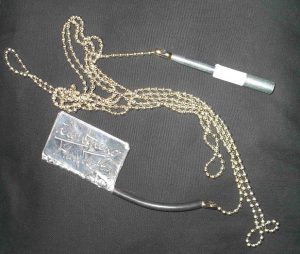
The contact pad was made of either cardboard or leather and then covered in aluminum foil. Certainly not ideal, but at least a device with an engineered safety spark gap. The safety spark gap is created using a PTFE (aka Teflon®) connector. ETP has probably done its homework. PTFE is the plastic with the highest arc resistance (aka “track resistance”) and might never have a problem with carbon tracking, but that’s just my guess. A couple of devices built in the same way are still being sold with the pad made of solid metal.

Advanced designs today have a spark gap encased in glass, which will never have a problem with carbon tracking. These devices also offer the reassurance that you can visually check that the safety spark gap is indeed working when the wand is on.
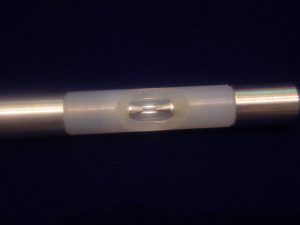
DV8™ uses solid machined aluminum parts connected with translucent Nylon. The tips of the two aluminum parts creating the spark gap are encased in a borosilicate glass tube inside the Nylon connector.
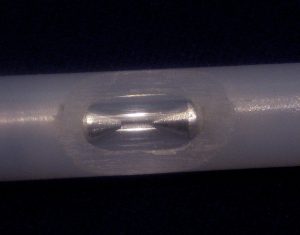
The glass tube is protected by the Nylon connector against breakage and at the same time translucent. This way one can visually check the spark gap whenever the wand is working. No megger needed, no trust needed, just your eyes! As mentioned before, the safety issues discussed are also valid for non-glass electrodes, but they are much more important for body contact devices, which are for extended time connected to the skin of one of the players and sometimes even strapped or taped to them so that in an emergency there is no way to get rid of them real fast. As for the conductor itself, we are using carbon fiber inside silicone insulation.
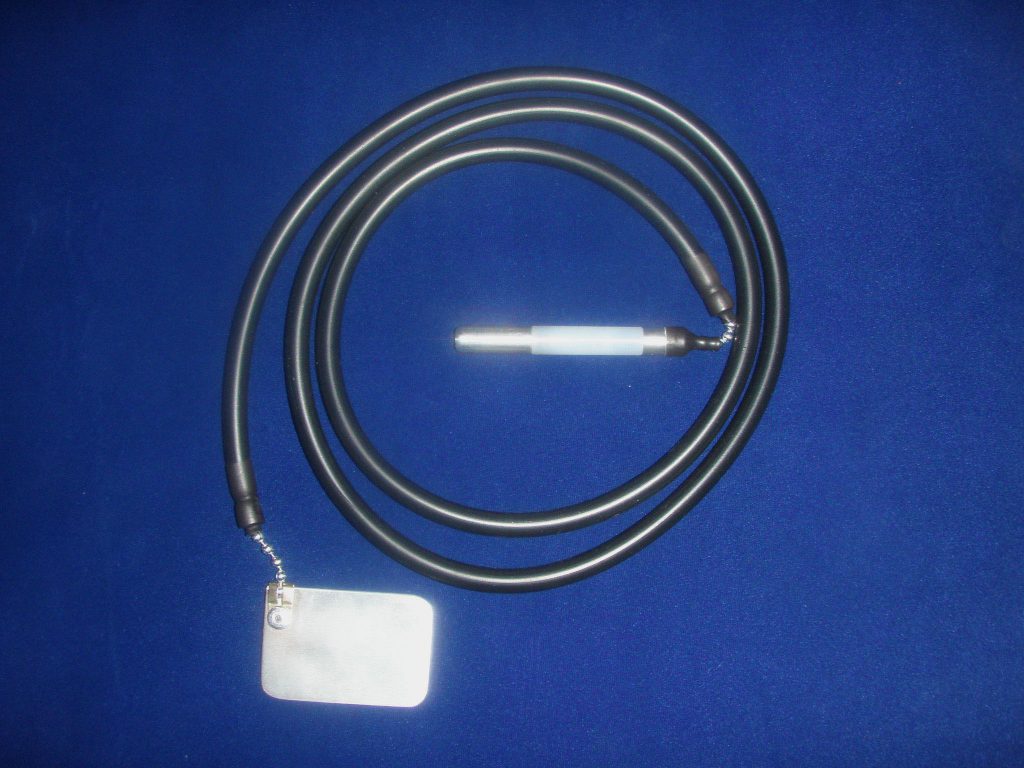
The other good material would be high voltage silicone insulated copper cable rated 50 kV up to 100 kV (1 kV = 1,000 Volts). We have built one device with 50 kV rated, silicone insulated cable and tested it against one of our standard devices made with the insulated carbon fiber conductor.
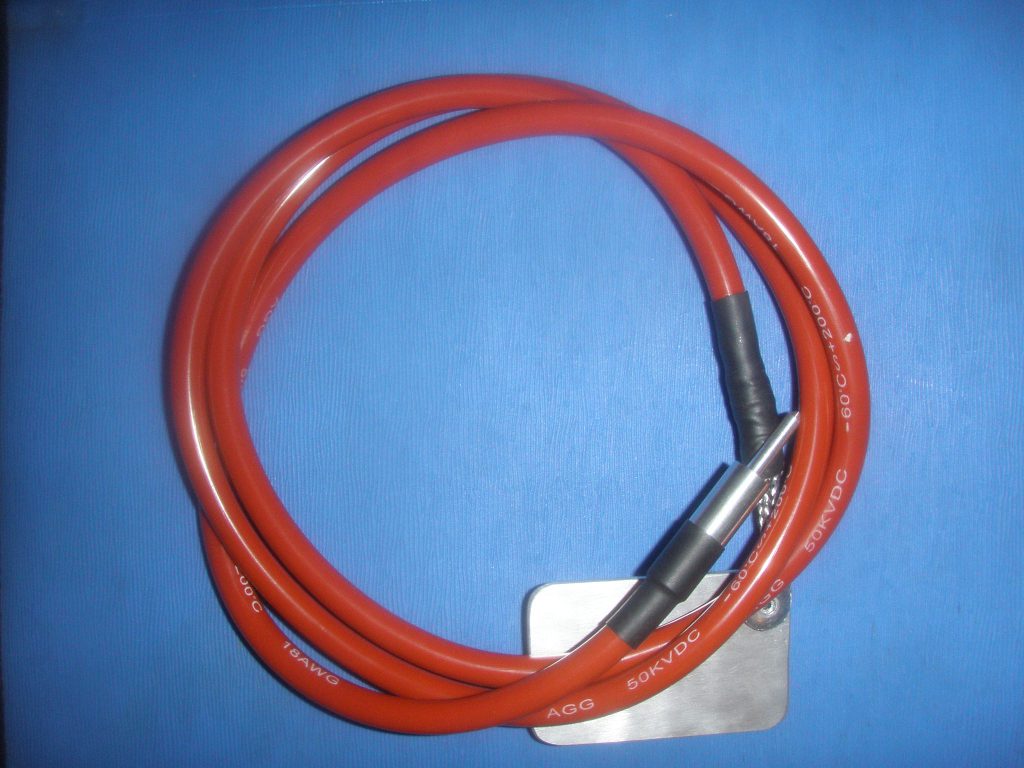
Neither was spark length to a grounded object visibly different nor could 5 blindfolded people detect any difference in sensation between the two devices. A customer who has one of our devices and one of a competitor’s devices built with 100 kV rated copper cable, which is 1/2 inch thick (the insulation is about 99% of that), wrote “…both give a slight power loss over the length of the cable, but the difference between the two is not significant. Your cable is also slightly longer (20cm). Finally, I like the swivel bit, it’s very good…”.
The construction of our devices with a carbon fiber conductor with silicone insulation offers distinct advantages:
- considerably lighter
- much more flexible
- the conductor will never break (unless you tow a car with it)
- swivel function on both sides (except 2-foot version, which only swivels on one side)
We decided for carbon fiber conductors for our devices, even if there is an insignificant energy loss, as the advantages by far outweigh that.
DV8™ is the only manufacturer selling body contact devices in 5 different lengths (and all 4 connector sizes to cover every Wand on the planet), which brings us to our final point. All body contact devices cause some energy loss due to (mostly) capacitive loss and corona loss over their length. The “no loss cable” one manufacturer claims to use is fiction, the laws of physics work for and against all of us! To decrease those losses you can do two things: Most important, keep you device away from the floor and from conductive devices (mostly appliances and metal furniture/furniture with metal legs) and secondly (this is less important but still worth mentioning), don’t buy a devices longer than you need to do the job for you. On the other hand, don’t hesitate to buy a 6 foot Body Contact Device, if you want the extra length to be able to move around. Most devices on the market are about 5 feet long. The 4 and 6 foot lengths are what we sell most.
Here are my thoughts on playing with body contact devices.
